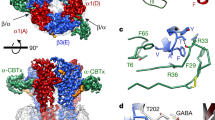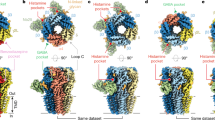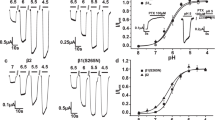Abstract
A common feature of general anaesthetic agents is their ability to potentiate neuronal inhibition through GABAA (γ-aminobutyric acid) receptors1. At concentrations relevant to clinical anaesthesia, these agents cause a dramatic stimulation of the chloride currents that are evoked by the binding of the natural ligand, GABAA. Although there is widespread evidence that the sensitivity of GABAA receptors to anaesthetic agents is heterogeneous2–4, the structural basis of these differences is largely unknown. Variations in subunit composition can have profound effects on the sensitivity of GABAA receptors to modulatory agents such as benzodiazepines5. However, strict subunit specificity has not been demonstrated for the potentiating effects of anaesthetic agents6–10. Here we describe a new class of human GABAA receptor subunit (η) that can assemble with α- and β-subunits and confer an insensitivity to the potentiating effects of intravenous anaesthetic agents. The η-subunit also abolishes the normal outward rectification of recombinant receptors in which it assembles. The expression pattern of this subunit in the brain suggests a new target for manipulation of neuronal pathways within the basal ganglia.
This is a preview of subscription content, access via your institution
Access options
Subscribe to this journal
Receive 51 print issues and online access
$199.00 per year
only $3.90 per issue
Buy this article
- Purchase on Springer Link
- Instant access to full article PDF
Prices may be subject to local taxes which are calculated during checkout
Similar content being viewed by others
References
Franks, N. P. & Lieb, W. R. Nature 367, 607–614 (1994).
Bureau, M. N. & Olsen, R. W. J. Neurochem. 61, 1479–1491 (1993).
Morrow, A. L., Pace, J. R., Purdy, R. H. & Paul, S. M. Mol. Pharmacol. 37, 263–270 (1990).
Harris, B., Wong, G. & Skolnick, P. J. Pharmacol. Exp. Ther. 265, 1392–1398 (1993).
Pritchett, D. B. et al. Nature 338, 582–585 (1989).
Thomson, S. A., Whiting, P. J. & Wafford, K. A. Br. J. Pharmacol. 117, 521–527 (1996).
Hadingham, K. L. et al. Mol. Pharmacol. 44, 1211–1218 (1993).
Puia, G. et al. Neuron 4, 759–765 (1990).
Sanna, E. et al. J. Pharmacol. Exp. Ther. 274, 353–360 (1995).
Mihac, S. J., Whiting, P. J. & Harris, R. A. Eur. J. Pharmacol. 268, 209–214 (1994).
Whiting, P. J., McKernan, R. M. & Wafford, K. A. Int. Rev. Neurobiol. 38, 95–138 (1995).
Bell, K., Churchhill, L. & Kalivas, P. W. Synapse 20, 10–18 (1995).
Wisden, W., Laurie, D. J., Monyer, H. & Seeburg, P. H. J. Neurosci. 12, 1040–1062 (1992).
Schmieden, V., Kuhse, J. & Betz, H. EMBO J. 11, 2025–2032 (1992).
Saxena, N. C. & Macdonald, R. L. J. Neurosci. 14, 7077–7086 (1994).
Verdoorn, T. A., Draguhn, A., Ymer, S., Seeburg, P. H. & Sakmann, B. Neuron 4, 919–928 (1992).
Davies, P. A., Kirkness, E. F. & Hales, T. G. Br. J. Pharmacol. 120, 899–909 (1997).
Gray, R. & Johnston, D. J. Neurophysiol. 54, 134–142 (1985).
Segal, M. & Barker, J. L. J. Neurophysiol. 51, 500–515 (1984).
Bormann, J., Hamill, O. P. & Sakmann, B. J. Physiol. (Lond.) 385, 243–286 (1987).
Gage, P. W. & Chung, S. H. Proc. R. Soc. Lond. B 255, 167–172 (1994).
Korpi, E. R. & Luddens, H. Mol. Pharmacol. 44, 87–92 (1993).
Peters, J. A., Kirkness, E. F., Callachan, H., Lambert, J. J. & Turner, A. J. Br. J. Pharmacol. 94, 1257–1269 (1988).
Zhu, W. J., Wang, J. F., Krueger, K. E. & Vicini, S. J. Neurosci. 16, 6648–6656 (1996).
Bergman, H., Wichmann, T. & DeLong, M. R. Science 249, 1436–1438 (1990).
Goetz, C. G. & Diederich, N. J. Nature Med. 2, 510–514 (1996).
Adams, M. D. et al. Nature (suppl.) 377, 3–174 (1995).
Tokunaga, K. et al. Cancer Res. 47, 5616–5619 (1987).
Buller, A. L., Hastings, G. A., Kirkness, E. F. & Fraser, C. M. Mol. Pharmacol. 46, 858–865 (1994).
Adodra, S. & Hales, T. G. Br. J. Pharmacol. 115, 953–960 (1995).
Author information
Authors and Affiliations
Rights and permissions
About this article
Cite this article
Davies, P., Hanna, M., Hales, T. et al. Insensitivity to anaesthetic agents conferred by a class of GABAA receptor subunit. Nature 385, 820–823 (1997). https://doi.org/10.1038/385820a0
Received:
Accepted:
Issue Date:
DOI: https://doi.org/10.1038/385820a0
This article is cited by
-
Structure-function Studies of GABA (A) Receptors and Related computer-aided Studies
Journal of Molecular Neuroscience (2023)
-
Electrophysiology of ionotropic GABA receptors
Cellular and Molecular Life Sciences (2021)
-
Rational approaches for the design of various GABA modulators and their clinical progression
Molecular Diversity (2021)
-
Analysis of γ-Aminobutyric Acid (GABA) Type A Receptor Subtypes Using Isosteric and Allosteric Ligands
Neurochemical Research (2014)
-
Some insights into the binding mechanism of the GABAA receptor: a combined docking and MM-GBSA study
Journal of Molecular Modeling (2013)
Comments
By submitting a comment you agree to abide by our Terms and Community Guidelines. If you find something abusive or that does not comply with our terms or guidelines please flag it as inappropriate.



